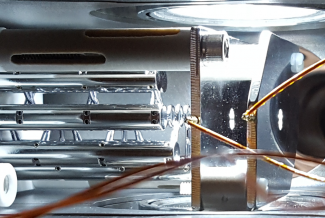The traveling wave decelerator utilizes ring electrodes charged to voltages that vary sinusoidially both in space and time. The end effect is 3D potential well that is co-moving with cold polar molecules. These packets are slowed continuously to trappable velocities by the end of the 624 ring electrodes that make up the traveling wave ring decelerator.
Currently, we use the traveling wave decelerator to provide molecular beams with controllable mean velocities. In the near future, we will couple this decelerator to our ion trap to investigate cold collision studies. We will be able to vary the collision energy between the reactants and thus tune over collision channel thresholds. For more info, see our cold ions, cold neutrals page.



 The Physics Frontiers Centers (PFC) program supports university-based centers and institutes where the collective efforts of a larger group of individuals can enable transformational advances in the most promising research areas. The program is designed to foster major breakthroughs at the intellectual frontiers of physics by providing needed resources such as combinations of talents, skills, disciplines, and/or specialized infrastructure, not usually available to individual investigators or small groups, in an environment in which the collective efforts of the larger group can be shown to be seminal to promoting significant progress in the science and the education of students. PFCs also include creative, substantive activities aimed at enhancing education, broadening participation of traditionally underrepresented groups, and outreach to the scientific community and general public.
The Physics Frontiers Centers (PFC) program supports university-based centers and institutes where the collective efforts of a larger group of individuals can enable transformational advances in the most promising research areas. The program is designed to foster major breakthroughs at the intellectual frontiers of physics by providing needed resources such as combinations of talents, skills, disciplines, and/or specialized infrastructure, not usually available to individual investigators or small groups, in an environment in which the collective efforts of the larger group can be shown to be seminal to promoting significant progress in the science and the education of students. PFCs also include creative, substantive activities aimed at enhancing education, broadening participation of traditionally underrepresented groups, and outreach to the scientific community and general public.